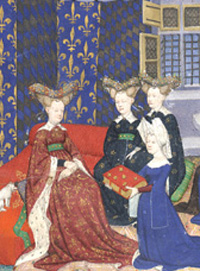 The preparation of a collected manuscript involved a range of operations which required careful co-ordination. Research on Harley 4431 (e.g. J. C. Laidlaw, Modern Language Review, 82 (1987), 35-75) has shown that Christine encountered problems, even though by 1413 she had become an experienced publisher: insufficient room was left for some rubrics; there is inelegant blank space between certain works; the contents have been adjusted, leaves being added to quire 6 and deleted from quire 34. Variations in the colour of the ink or changes of hand suggest that operations were sometimes interrupted until Christine supplied further material.
The preparation of a collected manuscript involved a range of operations which required careful co-ordination. Research on Harley 4431 (e.g. J. C. Laidlaw, Modern Language Review, 82 (1987), 35-75) has shown that Christine encountered problems, even though by 1413 she had become an experienced publisher: insufficient room was left for some rubrics; there is inelegant blank space between certain works; the contents have been adjusted, leaves being added to quire 6 and deleted from quire 34. Variations in the colour of the ink or changes of hand suggest that operations were sometimes interrupted until Christine supplied further material.
The second section of the manuscript, containing the Epistre Othéa, has provoked debate. Sandra Hindman (British Library Journal, 9 (1983), 93-123) has argued that, because the outer margins of the leaves have been widened by scarfing, the copy of the Epistre Othéa was prepared as an independent codex, and was later enlarged to match the format of the other seven sections. However, there is evidence that some folios of the Othéa have not been enlarged and that many folios in other sections have also been scarfed.
Description of Harley 4431
The object of the description is to determine how the manuscript was planned and prepared: on which of the earlier presentation manuscript(s) it was based; the order of operations; how the plan changed as work progressed; how many scribes and artists were involved and what were their roles; the arrangements for 'proof-reading', correcting, and assembling the eight sections before the codex was bound. A comprehensive description of the parchment will indicate how consistent are the ruling, lay-out and written area throughout the manuscript, and the extent of repairs.
Transcription of Harley 4431 and Software
The transcription has a dual aim: to interpret and complement the digital images for presentation on the project's website, and to create the corpus from which the concordance and glossary will be made. The software to be employed in encoding the text was developed by Dr Robert Sanderson of the University of Liverpool for his electronic edition of a manuscript of Froissart's Chronicles, linking digital images and transcribed text. The program is extremely flexible: images, transcription and annotations can be presented separately or in conjunction, as the viewer chooses. A range of options makes it possible to customize the transcription, e.g. by leaving abbreviations unexpanded, by showing only scribal punctuation, or by presenting an edited text which follows modern, scholarly conventions. The Sanderson software has provided a firm platform for work on Harley 4431; it has been developed to take account of the particular needs identified by the research team.
Luna Imaging's Insight software has been chosen as the project's primary digital image management and delivery system. This scalable system combines the retrieval and display of text information with an equally rich set of tools for viewing, comparing and organizing very high quality images. The program has been employed very successfully by Edinburgh University Library since 2000.
Decoration
Previously published descriptions of the decoration of Harley 4431 centre on the miniatures, much less attention being paid to the secondary elements (borders, initials and paragraph marks). Account will be taken of all the decorative components, the better to understand how the decorative programme was conceived and executed.
Language
The concordance of Harley 4431 and the Christine de Pizan Database provide invaluable data for research on Christine's lexis and morpho-syntax. For comparative purposes reference will be made to the works of Christine's near contemporaries, Eustache Deschamps (ca.1340-1404) and Alain Chartier (ca.1385-1
430), to which the team have access in electronic form.
Scribal Hands and Orthography
Gilbert Ouy and Christine Reno have argued that Scribe X, who copied much of Harley 4431, is to be identified with Christine de Pizan herself: Scriptorium, 34 (1980), 221-38. Parussa and Laidlaw take a different view: Epistre Othea, Geneva, 1999; Christine de Pizan: a Casebook, New York and London, 2003, 231-49. Ouy and Reno, and Parussa have highlighted the importance of spelling preferences in characterising Christine's scribes: Revue des langues romanes, 92 (1988), 265-86; Romania, 117 (1999), 143-59.



